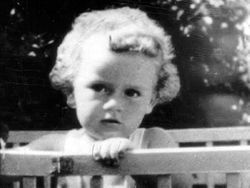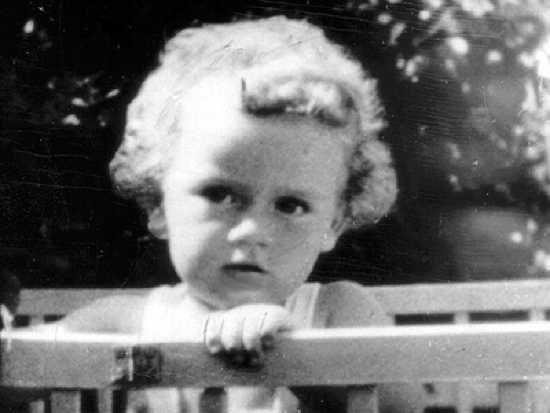Murder Victim. His death resulted in the enactment of the "Lindbergh Law," which made kidnapping a federal felony offense. The press nicknamed him the "Eaglet." First born child of famed aviator Charles Lindbergh and his wife, Anne Morrow Lindbergh, he was kidnapped from his second floor bedroom the evening of March 1, 1932, between the hours of 8:00pm and 10:00pm. Police were immediately notified, and a crude wooden ladder was found leading up to the nursery window outside the house. Left on the windowsill was an envelope containing a crudely written ransom note, demanding $50,000 for return of the baby. On March 4, a second letter was received in the mail, upping the demand to $70,000, and scolding Lindbergh for calling the police. On the evening of April 2, John F. Condon, a friend of Lindbergh's who agreed to be a go-between, delivered $70,000 in marked gold certificate bills to the unknown kidnapper, receiving a hand-written note indicating where the baby could be found. The baby could not be located at the indicated place in the note. On May 12, some 73 days after the kidnapping, the body of an infant child was found in the woods only four miles from the Lindbergh estate at Hopewell, New Jersey. Identified as young Charles, Jr. the cause of death was determined as a massive fracture of the skull, apparently delivered the night he was kidnapped. On September 15, 1934, a man later identified as Richard Hauptmann, purchased gasoline and paid for it using one of the ransom gold certificates. The gas station attendant, thinking that the bill might be counterfeit, wrote down a description of the car and its license plate. After the car was traced to Hauptmann, the police arrested him and searched his house. Found in the garage were $14,000 of the ransom money. A rafter missing from the house attic matched one of the timbers used to make the ladder. Letters that Hauptmann wrote to friends in Germany matched the handwriting of the ransom notes, and one of the ransom notes was signed with Hauptmann's initials. After a well publicized "Trial of the Century" Hauptmann was convicted of the kidnapping and murder of Charles Lindbergh, Jr, and was executed in the electric chair on April 3, 1936. After the verdict, the Lindberghs sailed to Europe to escape the hate mail, death threats and the frightening "paparazzi" tabloid press who wanted photos of them and their four-year-old second son, Jon.
Murder Victim. His death resulted in the enactment of the "Lindbergh Law," which made kidnapping a federal felony offense. The press nicknamed him the "Eaglet." First born child of famed aviator Charles Lindbergh and his wife, Anne Morrow Lindbergh, he was kidnapped from his second floor bedroom the evening of March 1, 1932, between the hours of 8:00pm and 10:00pm. Police were immediately notified, and a crude wooden ladder was found leading up to the nursery window outside the house. Left on the windowsill was an envelope containing a crudely written ransom note, demanding $50,000 for return of the baby. On March 4, a second letter was received in the mail, upping the demand to $70,000, and scolding Lindbergh for calling the police. On the evening of April 2, John F. Condon, a friend of Lindbergh's who agreed to be a go-between, delivered $70,000 in marked gold certificate bills to the unknown kidnapper, receiving a hand-written note indicating where the baby could be found. The baby could not be located at the indicated place in the note. On May 12, some 73 days after the kidnapping, the body of an infant child was found in the woods only four miles from the Lindbergh estate at Hopewell, New Jersey. Identified as young Charles, Jr. the cause of death was determined as a massive fracture of the skull, apparently delivered the night he was kidnapped. On September 15, 1934, a man later identified as Richard Hauptmann, purchased gasoline and paid for it using one of the ransom gold certificates. The gas station attendant, thinking that the bill might be counterfeit, wrote down a description of the car and its license plate. After the car was traced to Hauptmann, the police arrested him and searched his house. Found in the garage were $14,000 of the ransom money. A rafter missing from the house attic matched one of the timbers used to make the ladder. Letters that Hauptmann wrote to friends in Germany matched the handwriting of the ransom notes, and one of the ransom notes was signed with Hauptmann's initials. After a well publicized "Trial of the Century" Hauptmann was convicted of the kidnapping and murder of Charles Lindbergh, Jr, and was executed in the electric chair on April 3, 1936. After the verdict, the Lindberghs sailed to Europe to escape the hate mail, death threats and the frightening "paparazzi" tabloid press who wanted photos of them and their four-year-old second son, Jon.
Bio by: Kit and Morgan Benson
Family Members
Advertisement
See more Lindbergh memorials in:
Advertisement






